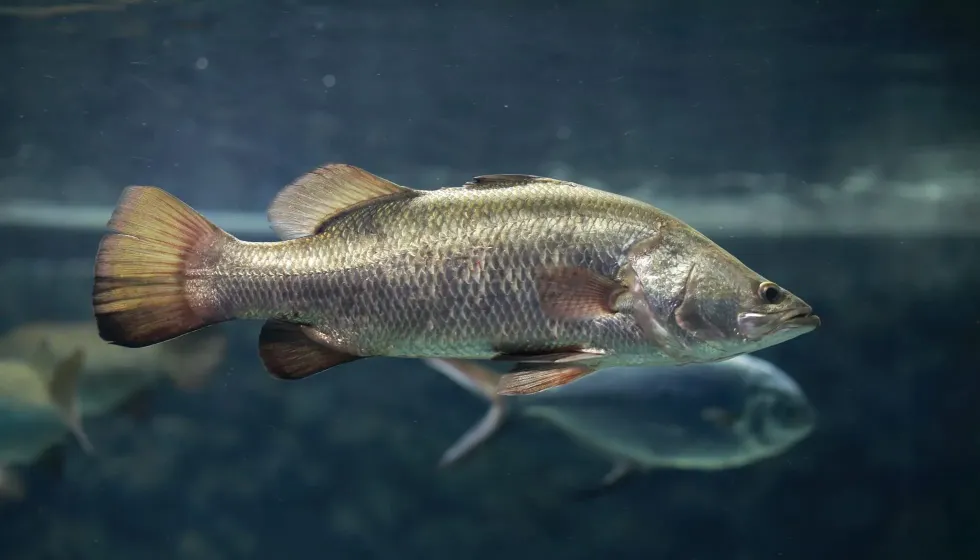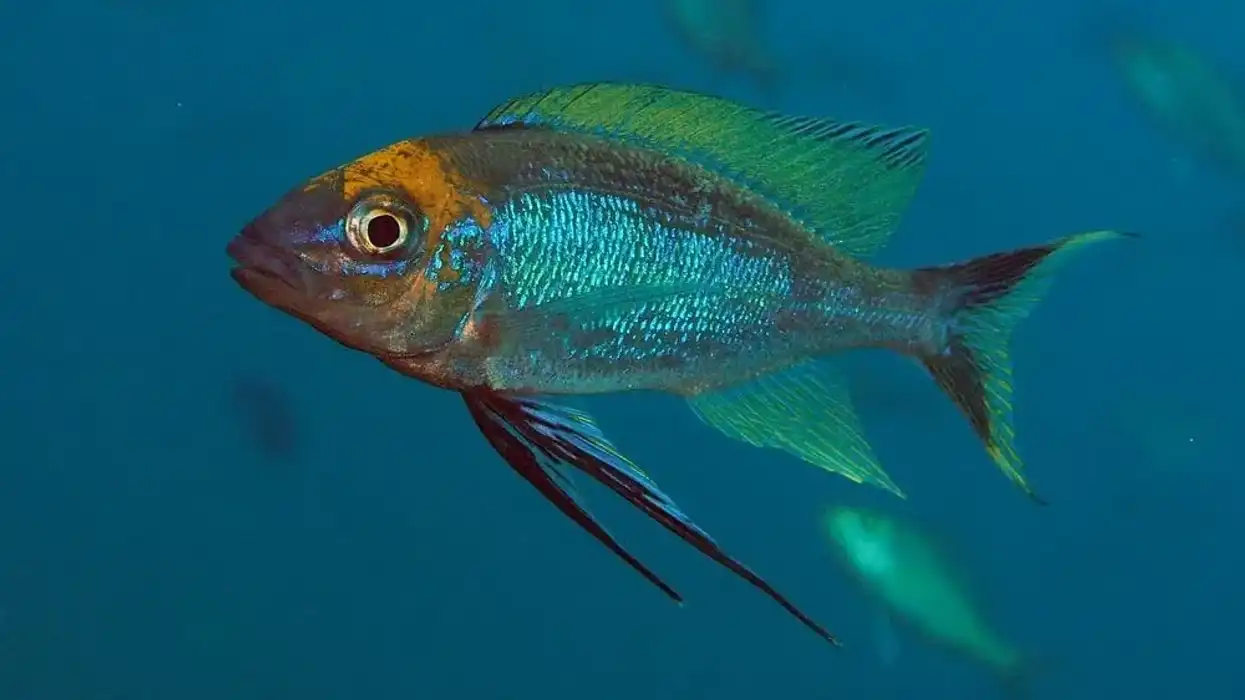There are two known species of silver perch found in the world. Each species is part of a different family and found countries apart. The silver perch (Bairdiella chrysoura) is native to the east coast of the United States while the silver perch (Bidyanus bidyanus) is native to south-eastern Australia.
The silver perch from America is among the smaller members of the drum family and has an oval-shaped body with no barbels. This fish with its small size is considered to be plain colored with an olive, greenish, or bluish back and a silvery-white colored belly.
All its fins are yellowish in color with a darker coloration in the dorsal fin, caudal fin, and the tips of the anal fin.
These small fishes are caught by fishers in large numbers while they are trying to catch large fishes. Fishermen use small silver perch either as bait to catch large fish or use them for their own personal consumption.
This silver perch is also known as sand perch.
This fish can be easily recognized by the lack of one to two prominent canine teeth seen at the tip of the upper jaw and the absence of chin pores. These features can be seen on sea trout, a lookalike of the silver perch.
Peak spawning occurs for this species from March to June in the spring season and the larvae and small juveniles move upstream into freshwater areas. After they grow larger, this fish is known to return from upstream to the higher-salinity shallows near bay grass beds.
For more relatable content, check out these channel catfish facts and guppy interesting facts.
Silver Perch Interesting Facts
What type of animal is a silver perch?
The silver perch (Bairdiella chrysoura) is a part of the drum fish family which consists of species of fish like spot, red drum, black drum, weakfish, and spotted sea trout.
What class of animal does a silver perch belong to?
The American silver perch (Bairdiella chrysoura) and the Australian silver perch (Bidyanus bidyanus) both fall under the class Actinopterygii in the kingdom of Animalia.
How many silver perches are there in the world?
The population is not known but is considered to be stable when recorded even after continuous fishing in the areas of their occurrence.
Currently, there is no danger to the populations of this species found in America. However, the populations of silver perch native to Australia are currently threatened and if not controlled, the decline in their numbers could lead to drastic changes to the environment.
Where does a silver perch live?
Silver perch are saltwater fish and this fish species is found along the shore waters of the Caribbean and the Atlantic waters from Texas to New York. The fish is native to the east coast of the United States.
The range is from New York to Florida, Mexico, and the Gulf of Mexico. This fish is often caught by fishers in this range of habitat.
What is a silver perch's habitat?
The silver perch habitat includes tidal creeks, rivers, seagrass beds, and marshes. This species is found in an environment of inshore regions and also mud and sand bottoms of nearshore estuary waters. Along with the marine water range, the habitat of this fish is also in freshwater areas, rivers, and brackish water.
Who do silver perches live with?
The information on the company these fish keep is not available.
How long does a silver perch live?
A silver perch fish lives to an age of up to six years.
How do they reproduce?
Spawning is known to be done in late spring and early summer in the deeper areas of smaller tidal creeks in the higher salinity areas. The number of eggs is not recorded for this species.
Eggs and larvae stay in inshore areas until the larvae can swim properly. After that, this species is found in shallow tidal creeks.
The young accept food in the form of small decapod crustaceans and fishes. During the fall season when the larvae grow into the juvenile form, the young move to deeper creeks from upstream areas.
It is said that late March to June is the time when peak spawning occurs when the young and larvae move upstream to fresher waters.
The silver perch from Australia lays around 20,0000-30,0000 eggs at a time. The clutch size is quite big when compared to other species. The eggs take 24-36 hours to hatch.
What is their conservation status?
The conservation status of the American silver perch is categorized as Least Concern by the IUCN Red List. There is no danger to this species at the moment and are found abundantly in their freshwater as well as saltwater habitats.
Silver Perch Fun Facts
What do silver perches look like?
The silver perch has an oval-shaped body without barbels. A silvery-white belly can be seen in a plain olive, greenish, or bluish back.
Yellow-colored fins can be seen on the body and the dorsal fin, caudal fin, and the tip of the anal fins are all of darker color. This fish has a large mouth with the lower jaw projecting further than the upper jaw. The chin has three pairs of mental pores.
The silver perch from Australia is a freshwater fish that is medium-sized. It has a small head, small eyes, and a small mouth.
How cute are they?
They are considered quite cute.
How do they communicate?
These fishes communicate by sound, motion, electrical impulses, and smell.
How big is a silver perch?
Silver perches usually have a length of 8-10 in (20.32-25.4 cm), however the size limit of this fish can reach up to 12 in (30.48 cm) at times.
How fast can a silver perch swim?
The speed of a silver perch is not known.
How much does a silver perch weigh?
The weight of the fish is not known. However, the size of a silver perch is quite small with respect to other species.
Silver perch fingerlings have a weight that has a range of 0.66-0.77 lb (299.3-349.2 g) in a year. They grow up pretty quickly and attain a weight with a range of 1.1-1.76 lb (499-798.3 g) in one to two years.
What are the male and female names of the species?
Males and females are not given different names.
What would you call a baby silver perch?
A baby silver perch is called a juvenile or young. The eggs hatch and larvae emerge.
What do they eat?
Silver perch fish is known to feed mostly on small crustaceans, silversides, anchovies, and herring. Feeding silver perch is easy as they commonly accept food like crabs, shrimps, marine worms, and other fishes.
Are they dangerous?
They are not dangerous.
Would they make a good pet?
They are considered hardy pets and are kept in many parts of the world.
Raising silver perch is not a big task for an enthusiast. An artificial diet is readily accepted by a silver perch. Food in pellet form is the way to go for feeding this fish in a tank.
Did you know...
Although it sometimes has a weedy or muddy flavor, the meat of silver perch is considered quite tasty by many.
To catch a silver perch, fishing techniques with baits like cut fish, squid strips, shrimp, clams, and blood worms can be used. These baits can be attached to small hooks and then dropped into the water.
The diet of silver perch fish consists of crustaceans, small fishes, and worms.
Why are silver perches protected?
As it affects the long time conservation of this species, silver perch numbers are dramatically decreasing. Over-fishing can cause the removal of mature adults from the range which can disturb breeding activities.
What is unique about silver perches?
Sand seatrouts look similar in appearance to the silver perch. However, the latter does not possess any canine teeth at the tip of the upper jaw.
The teeth are also small in the upper and lower jaw. The silver perch also does not have a barbel. Unlike most species, even silver perches from Australia, the Bairdiella chrysoura is found in saltwater too.
Here at Kidadl, we have carefully created lots of interesting family-friendly animal facts for everyone to discover! For more relatable content, check out these rainbow cichlid facts and koi fun facts for kids.
You can even occupy yourself at home by coloring in one of our free printable silver perch coloring pages.










